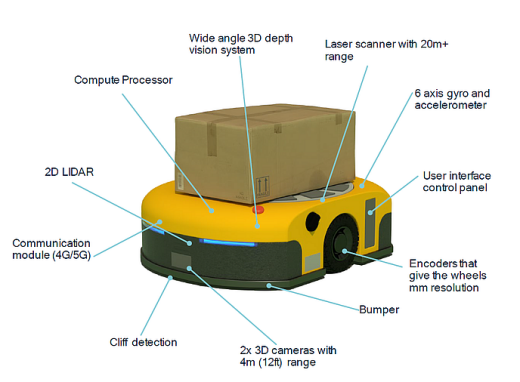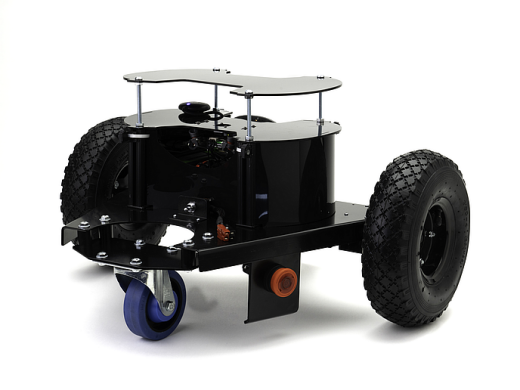Mobile Robot Technology
Are you looking for ways to start your company’s robot development? Or are you already developing robots and looking for ways to make them smarter?
Either way, we have three things to tell you.
Autonomous Mobile Robots (AMRs) are robots that use machinery to augment human effort. They are autonomous because they are designed to perform useful work without constant human intervention. They are mobile because they can easily move themselves from one place to another to perform work.
We recently held a webinar called “Design Considerations for Autonomous Mobile Robots” that aligned with the developer’s view of common features of AMRs. It covered the relationship between sensors, intelligence, and computational engines that are common to designing AMRs in general, but specifically in the rapidly growing application sector of e-business fulfillment.
E-Commerce Fulfillment AMR
By 2025, there will be up to 4 million commercial robots operating in 50,000 warehouses worldwide. They will perform tasks such as receiving, picking, sorting, packing, and simply moving goods automatically from point A to point B in the warehouse.
Performing this work depends on four key functions.
● Perception
● Thinking
● Action
● Communication
Of course, for warehouse workers, you can take these functions for granted. But with robots, you have to have them built in, with features like sensors, algorithms, computer vision, and artificial intelligence. Plus heterogeneous computing to keep everything running smoothly.
The AMR in the figure below, typically used for e-commerce fulfillment, is a good example.
Breaking down autonomy into tasks
Now think about the tasks the AMR needs to perform and how it will use these capabilities and heterogeneous computing to perform them.

See your surroundings in 3D
AMR uses sensors and cameras not only to sense nearby objects, but also to understand the physical relationships between them. This means processing synopses from the following components.
● Structured light cameras – decoding the projected pattern of pixels in the scene
● Time-of-flight cameras – measure the distance that light travels
● Stereo cameras – capturing multiple pictures from different cameras
●Lidar – illuminates a target with a laser and analyzes the reflected light
●SonAR – emits sound pulses and listens for echoes
Create a 3D map of your surroundings
Based on feedback from the camera, AMR uses simultaneous localization and mapping (SLAM) to build a 3D map of its environment as it moves around.
Find its position on the map
Next comes localization, where AMR determines its position on the 3D map. It combines motion data from the camera with inertial data from sensors and wheel encoders to better estimate motion and improve the accuracy of localization.
There are two approaches to SLAM.
● Vision SLAM – using a camera paired with an inertial measurement unit (IMU).
● LIDAR SLAM – using a laser sensor paired with an IMU; more accurate in one dimension, but often more expensive.
Note that 5G plays a role in localization. Private 5G networks in warehouses and fulfillment centers can enhance the on-board approach to SLAM.
Navigation
Once an AMR has a map and knows where it is on the map, it can navigate through its environment. Navigation involves.
● Scene understanding – using deep sensors and machine learning to build spatial and semantic models of the environment
● Path planning – finding the best path through the environment and meeting high-level objectives while avoiding obstacles
● Real-time control – implement motion plans by translating desired speed and direction into motor commands
● Motion estimation – estimate changes in position on the map. With a new location and environment, AMR updates the planned path.
Navigation includes adapting to changes in environmental elements such as people, shelves and walls. AMR relies on LiDAR to detect changes and uses machine learning to refine navigation objectives. They can also use indoor pinpointing to draw a grid using 5G transmission point/reception point (TRP) for centimeter-level accuracy in the x, y, and z axes.
Identifying Objects and Avoiding Obstacles
AMRs must recognize and interact with objects and bypass obstacles. This means they must rely heavily on computer vision and artificial intelligence as they continuously learn to recognize objects. High-performance AMRs perform these functions on the device, rather than sending data back and forth to the cloud.

Qualcomm is the world’s number one leader in wireless technology innovation.
Qualcomm is building a world where everyone and everything can be intelligently connected. Every day, you interact with products and technologies from Qualcomm, including 5G-enabled smartphones that double as professional-grade cameras and gaming devices, smarter vehicles and cities, and the technology behind the smart, connected factories that make your latest purchases. Our powerful connectivity solutions keep you connected – even in remote locations. Qualcomm 5G and AI innovations are the driving force behind the connected smart edge. You’ll find our technology behind and inside the innovations that bring tremendous value to multiple industries and billions of people every day.
See where we are 5G is bringing the world closer together.
We’ve invented the breakthroughs that make 5G possible. We’re taking on some of the world’s biggest challenges to positively impact society for the greater good. You’ll see 5G is transforming entire industries and supporting new ones, improving the way we work, live and play.
Related recommendations
-
Warehouse risks and preventive measures
546What are the rules and procedures for proper safety management in the warehouse? How to protect health and prevent accidents and injuries in the wo...
View details -
Ukrainian unmanned combat vehicles
704Milrem Robotics, an Estonia-based developer of robotic and autonomous systems, recently announced that it has signed a contract with German defense...
View details -
Benefits of robots in manufacturing
581The World Robotics Report 2021 shows that the number of robots per 10,000 employees rose from 66 to 126 globally between 2015 and 2020. So, which s...
View details -
International industrial robot technology is becoming increasingly mature
1739The future of automation depends on collaboration between manufacturers, partners and distributors to create applications that are integrated, acce...
View details
 Plutools
Plutools



HelloPlease log in